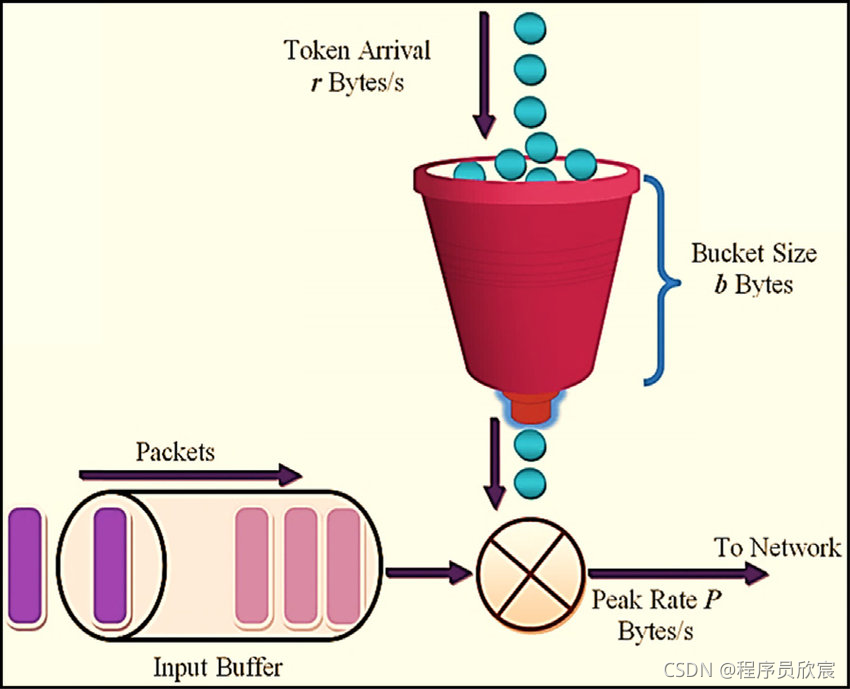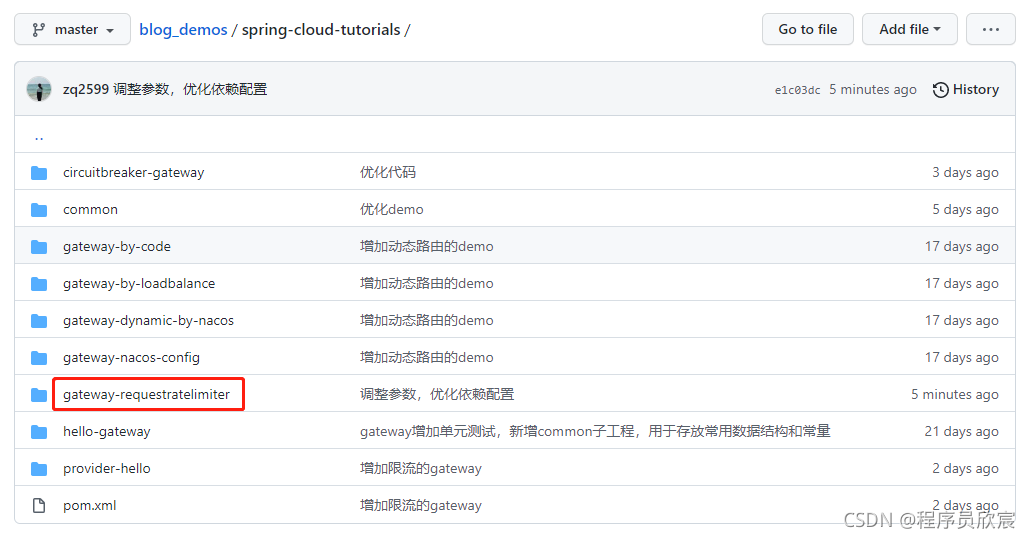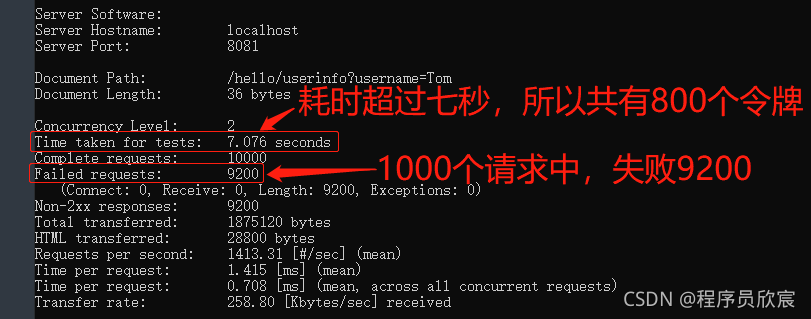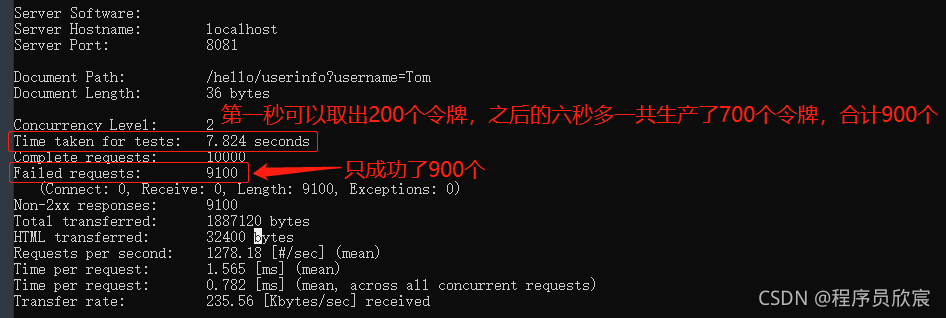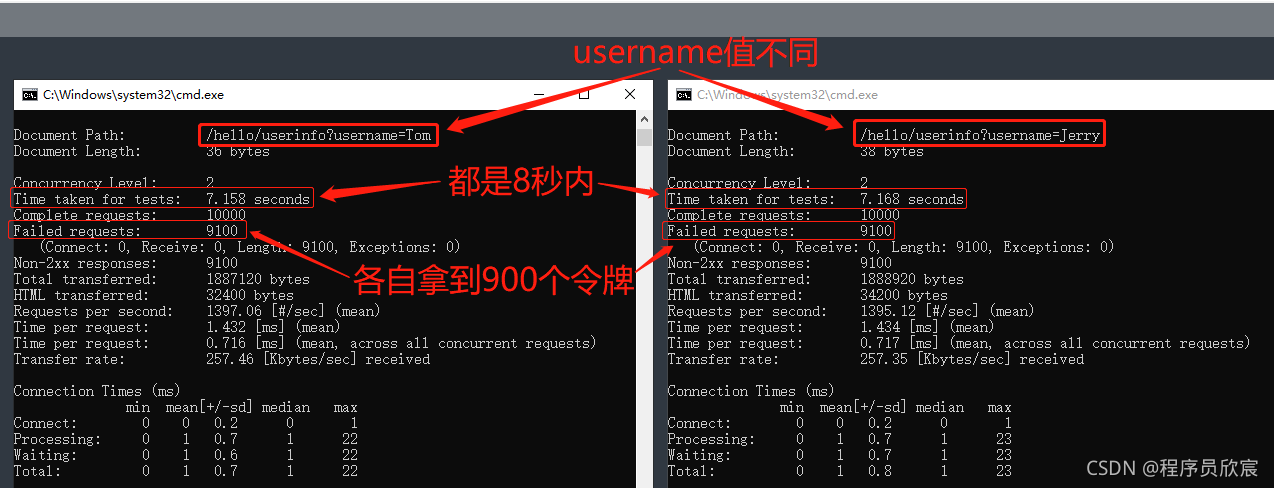Java教程
Spring Cloud Gateway限流实战
欢迎访问我的GitHub
https://github.com/zq2599/blog_demos
内容:所有原创文章分类汇总及配套源码,涉及Java、Docker、Kubernetes、DevOPS等;
本篇概览
-
本文是《Spring Cloud Gateway实战》系列的第八篇,经过前面的学习,咱们对过滤器已了解得差不多,今天来补全过滤器的最后一个版块:限流(RequestRateLimiter )
-
默认的限流器是基于redis实现的,限流算法是大家熟悉的令牌桶(Token Bucket Algorithm),关于令牌捅的原理就不在此展开了,聪明的您看一眼下图应该就懂了:装令牌的桶容量有限,例如最多20个,令牌进入桶的速度恒定(注意,这里是和漏桶算法的区别),例如每秒10个,底部每个请求能拿到令牌才会被处理:
RequestRateLimiter基本套路
- 使用RequestRateLimiter过滤器的步骤非常简单:
- 准备可用的redis
- maven或者gradle中添加依赖org.springframework.boot:spring-boot-starter-data-redis-reactive
- 确定按照什么维度限流,例如按照请求中的username参数限流,这是通过编写KeyResolver接口的实现来完成的
- 配置application.yml文件,添加过滤器
- 以上就是使用RequestRateLimiter过滤器的套路了,简单么?接下来,咱们先编码再验证
源码下载
- 本篇实战中的完整源码可在GitHub下载到,地址和链接信息如下表所示(https://github.com/zq2599/blog_demos):
| 名称 | 链接 | 备注 |
|---|---|---|
| 项目主页 | https://github.com/zq2599/blog_demos | 该项目在GitHub上的主页 |
| git仓库地址(https) | https://github.com/zq2599/blog_demos.git | 该项目源码的仓库地址,https协议 |
| git仓库地址(ssh) | git@github.com:zq2599/blog_demos.git | 该项目源码的仓库地址,ssh协议 |
- 这个git项目中有多个文件夹,本篇的源码在spring-cloud-tutorials文件夹下,如下图红框所示:
- spring-cloud-tutorials文件夹下有多个子工程,本篇的代码是gateway-requestratelimiter,如下图红框所示:
准备工作
- 为了更好的演示Gateway的效果,在服务提供者provider-hello的代码(Hello.java)中新增一个web接口,可以接受一个入参:
@GetMapping("/userinfo")
public String userInfo(@RequestParam("username") String username) {
return Constants.HELLO_PREFIX + " " + username + ", " + dateStr();
}
- 后面的测试咱们就用上述接口;
编码
- 在父工程spring-cloud-tutorials之下新增子工程gateway-requestratelimiter,其pom.xml内容如下,重点是org.springframework.boot:spring-boot-starter-data-redis-reactive:
<?xml version="1.0" encoding="UTF-8"?>
<project xmlns="http://maven.apache.org/POM/4.0.0"
xmlns:xsi="http://www.w3.org/2001/XMLSchema-instance"
xsi:schemaLocation="http://maven.apache.org/POM/4.0.0 http://maven.apache.org/xsd/maven-4.0.0.xsd">
<parent>
<artifactId>spring-cloud-tutorials</artifactId>
<groupId>com.bolingcavalry</groupId>
<version>1.0-SNAPSHOT</version>
</parent>
<modelVersion>4.0.0</modelVersion>
<artifactId>gateway-requestratelimiter</artifactId>
<dependencies>
<dependency>
<groupId>com.bolingcavalry</groupId>
<artifactId>common</artifactId>
<version>${project.version}</version>
</dependency>
<dependency>
<groupId>org.springframework.cloud</groupId>
<artifactId>spring-cloud-starter-gateway</artifactId>
</dependency>
<dependency>
<groupId>org.springframework.boot</groupId>
<artifactId>spring-boot-starter-data-redis-reactive</artifactId>
</dependency>
</dependencies>
</project>
- 配置文件application.yml,请注意RequestRateLimiter的几个参数,已经用中文添加了详细的注释:
server:
#服务端口
port: 8081
spring:
application:
name: circuitbreaker-gateway
# redis配置
redis:
host: 192.168.50.43
port: 6379
cloud:
gateway:
routes:
- id: path_route
uri: http://127.0.0.1:8082
predicates:
- Path=/hello/**
filters:
- name: RequestRateLimiter
args:
# 令牌入桶的速度为每秒100个,相当于QPS
redis-rate-limiter.replenishRate: 100
# 桶内能装200个令牌,相当于峰值,要注意的是:第一秒从桶内能去200个,但是第二秒只能取到100个了,因为入桶速度是每秒100个
redis-rate-limiter.burstCapacity: 200
# 每个请求需要的令牌数
redis-rate-limiter.requestedTokens: 1
- 指定限流维度的代码CustomizeConfig.java,这里是根据请求参数username的值来限流的,假设真实请求中一半请求的username的等于Tom,另一半的username的等于Jerry,按照application.yml的配置,Tom的请求QPS为10,Jerry的QPS也是10:
package com.bolingcavalry.gateway.config;
import org.springframework.cloud.gateway.filter.ratelimit.KeyResolver;
import org.springframework.context.annotation.Bean;
import org.springframework.context.annotation.Configuration;
import reactor.core.publisher.Mono;
import java.util.Objects;
@Configuration
public class CustomizeConfig {
@Bean
KeyResolver userKeyResolver() {
return exchange -> Mono.just(exchange.getRequest().getQueryParams().getFirst("username"));
}
}
- 毫无营养的启动类RequestRateLimiterApplication.java:
package com.bolingcavalry.gateway;
import org.springframework.boot.SpringApplication;
import org.springframework.boot.autoconfigure.SpringBootApplication;
@SpringBootApplication
public class RequestRateLimiterApplication {
public static void main(String[] args) {
SpringApplication.run(RequestRateLimiterApplication.class,args);
}
}
- 代码写完了,接下来开始验证;
验证(桶容量等于入桶速度)
-
首先验证的是桶容量等于入桶速度时的效果,请修改gateway-requestratelimiter应用的application.yml中文件,使得redis-rate-limiter.replenishRate和redis-rate-limiter.burstCapacity的值都等于100,也就是说桶的大小等于100,每秒放入的令牌数也是100
-
确保redis已经启动,并且与application.yml中的配置保持一直
-
启动nacos(provider-hello依赖)
-
启动服务提供者provider-hello
-
启动gateway-requestratelimiter
-
为了模拟web请求,我这里使用了Apache Benchmark,windows版本的下载地址:
https://www.apachelounge.com/download/VS16/binaries/httpd-2.4.48-win64-VS16.zip -
上述文件下载解压后即可使用,在控制台进入Apache24\bin后执行以下命令,意思是向指定地址发送10000个请求,并发数为2:
ab -n 10000 -c 2 http://localhost:8081/hello/userinfo?username=Tom
- 控制台输出如下,可见不到八秒的时间,只成功了800个,证明限流符合预期:
验证(桶容量大于入桶速度)
-
接下来试试桶容量大于入桶速度时的限流效果,这对于我们控制峰值响应有很重要的参考价值
-
请修改gateway-requestratelimiter应用的application.yml中文件,redis-rate-limiter.replenishRate维持100不变,但是redis-rate-limiter.burstCapacity改成200,也就是说每秒放入的令牌数还是100,但桶的容量翻倍了
-
重启应用gateway-requestratelimiter
-
再次执行以下命令,意思是向指定地址发送10000个请求,并发数为2:
ab -n 10000 -c 2 http://localhost:8081/hello/userinfo?username=Tom
- 测试结果如下图,可见符合预期,可以将桶内令牌全部用掉,以支撑峰值超过QPS的场景:
验证(根据username的维度限流)
-
接下来验证限流的维度,究竟是不是按照请求参数username的值来限流的
-
咱们打开两个命令行,同时发送请求(动作要快),第一个的username等于Tom,第二个等于Jerry,理论上推测,如果都是8秒内完成,那么每个命令都有900个请求能成功
-
测试结果如下图,可见符合预期,每个username用的是自己的令牌:
- 至此,Spring Cloud Gateway限流实战已经完成,如此简单易用的限流方案,希望能给您的学习和使用带来参考
我是欣宸,期待与您一同畅游Java世界…
https://github.com/zq2599/blog_demos
-
Java中定时任务实现方式及源码剖析11-24
-
Java中定时任务实现方式及源码剖析11-24
-
鸿蒙原生开发手记:03-元服务开发全流程(开发元服务,只需要看这一篇文章)11-24
-
细说敏捷:敏捷四会之每日站会11-24
-
Springboot应用的多环境打包入门11-23
-
Springboot应用的生产发布入门教程11-23
-
Python编程入门指南11-23
-
Java创业入门:从零开始的编程之旅11-23
-
Java创业入门:新手必读的Java编程与创业指南11-23
-
Java对接阿里云智能语音服务入门详解11-23
-
Java对接阿里云智能语音服务入门教程11-23
-
JAVA对接阿里云智能语音服务入门教程11-23
-
Java副业入门:初学者的简单教程11-23
-
JAVA副业入门:初学者的实战指南11-23
-
JAVA项目部署入门:新手必读指南11-23


